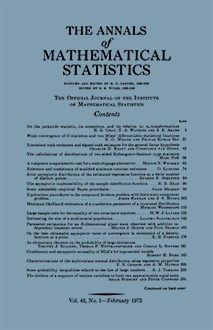Abstract
Suppose we are given $p$ objects to be weighed in $N$ weighings with a chemical balance having no bias. Let $X = (x_{ij})$ be the weighing design matrix, where $x_{ij} = + 1$ or $-1$ if the $j$th object is included in the $i$th weighing by being placed respectively in the left or right hand pan, and $x_{ij} = 0$ if the $j$th object is not weighed in the $i$th weighing. The weighing results may be represented by means of the following matrix equation, \begin{equation*}\tag{1.1} y = Xw + \epsilon,\end{equation*} where $y$ is the column vector of the results recorded in the $N$ weighings, $\epsilon$ is the column vector of the errors in these results and $w$ is the column vector of the true weights. Under the assumption that $\epsilon$ has mean $0_{N,1}$ and dispersion matrix $\sigma^2I_N$, where $0_{m\times n}$ is the $m \times n$ null matrix and $I_N$ is the $N$th order identity matrix, the normal equations estimating $w$ are given by the equation \begin{equation*}\tag{1.2}S\hat{w} = X'y,\end{equation*} where $S = X'X$ and $\hat{w}$ is the column vector of the estimated weights. The weighing designs problem was studied till now when $S$ is non singular (cf. Hotelling [1], Kishen [2], Mood [3], Raghavarao [4]). There is no recorded literature dealing with weighing designs whose $S$ is singular. Occasions may arise when the experimenter is faced with weighing designs whose $S$ is singular. We now define DEFINITION 1.1. A weighing design $X$ is said to be singular if the matrix $S$ is singular. The word "singular weighing design" in the above definition is somewhat misleading, but is used for the lack of a suitable word. Singular weighing designs may occur in the following cases. 1. Bad designing. As there are no best weighing designs tables, an experimenter who desires to use a particular order weighing design, has to construct one for himself before starting the weighing operations. In such circumstances bad designing may result in singular weighing designs. 2. Laboratory observations. Many scientists are of the opinion that they can achieve greater precision in their readings by repeating their experiments. The process of repeating weighing operations may also lead to singular weighing designs, when the number of independent linear weighing operations made is less than the number of objects. 3. Accidental. Though optimum or best weighing designs have been selected by the experimenter, accidentally some objects may fall down and break while taking the weighings. In that case, if the experimenter continues his weighing operations, putting $x_{ij} = 0$ for the broken objects, he may finally obtain a singular weighing design. For example, let an experimenter plan to weigh 5 objects in 5 weighings with the design $P_5$ of [4]. After two weighings, the first two objects fell down and broke. If he continues the weighing operations assuming $x_{ij} = 0 (i = 3, 4, 5; j = 1, 2)$, he gets a singular weighing design. This paper deals with two statistical questions. The first question concerns the estimability of individual weights of the objects and the second question considered is the taking of additional weighings so as to render the problem one of full rank and if possible so as to minimize the resulting generalized variance of the estimates, which is equivalent to Mood's efficiency definition. In Section 2, results on singular weighing designs together with some matrix lemmas are given, outlining the proofs wherever necessary. Necessary and sufficient conditions for the estimability of individual weights of the objects are given in Section 3 and the problem of taking additional weighings so as to obtain the estimates of all the objects is considered in Section 4.
Citation
Damaraju Raghavarao. "Singular Weighing Designs." Ann. Math. Statist. 35 (2) 673 - 680, June, 1964. https://doi.org/10.1214/aoms/1177703564
Information





